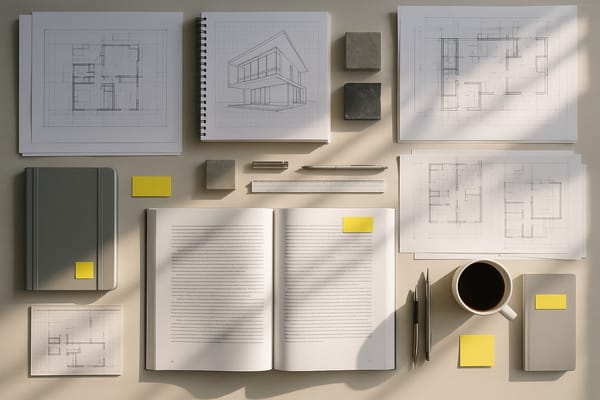Stop Overthinking—Make Mistakes That Don’t Cost Much
"Overthinking isn’t caution—it’s fear of making expensive mistakes, and the solution is to make those mistakes cheap enough that you can keep moving."

Creative work often grinds to a halt not because you lack ideas, but because every decision feels too heavy.
Which font family should I use?
Will the client hate this direction?
Should I buy that new plugin first?
Instead of moving forward, you circle the same questions for days. Overthinking feels like being careful, but really it’s fear of making an expensive mistake.
Here’s the truth: the most productive creatives aren’t better decision-makers. They just design their work so being wrong doesn’t cost much.
When mistakes are cheap, you stop agonising. You try, learn, adjust—and move.
Expensive Mistakes vs. Cheap Mistakes
Think about two different ways of approaching the same problem:
- Spending three weeks polishing a logo concept before the first client review = expensive mistake.
- Mocking up two quick sketches and testing the reaction on day one = cheap mistake.
- Investing £300 in a font you’re not sure you’ll use = expensive mistake.
- Testing the same idea with a free trial or a similar placeholder font = cheap mistake.
- Building an elaborate portfolio site before you know your positioning = expensive mistake.
- Sharing work-in-progress on Instagram or Behance to gauge interest = cheap mistake.
The lesson? Don’t eliminate mistakes—lower their price tag.
When mistakes cost less, you make more of them. And the more you make, the more you learn.
Why Freelancers Overthink
If lowering the cost of mistakes is so powerful, why don’t we do it? Because as freelancers and independent creatives, we’re conditioned to do the opposite.
- Every project feels like a make-or-break.When you’ve only got a few clients, one wrong step feels catastrophic. You think, “If I mess this up, I’ll never work with them again.” That fear magnifies every decision until it feels paralysing.
- We confuse polish with professionalism.We assume clients only respect finished, flawless work. In reality, most clients want to see thinking earlier. They’d rather course-correct on a rough sketch than pay for a beautifully polished wrong turn.
- Design culture glorifies perfection.Open Dribbble, Behance, or Instagram and you’ll see immaculate mockups. What’s hidden are the rough drafts, the dead ends, and the half-baked sketches. So we assume the messy middle isn’t part of the process—even though it always is.
But hiding the messy stage doesn’t protect us. It slows us down. It makes every project heavier than it needs to be.
The Psychology of Overthinking
Overthinking isn’t laziness. It’s a defence mechanism. Your brain is trying to protect you from pain—the pain of wasting time, losing money, or disappointing a client.
The problem? Avoiding all mistakes is impossible. You either:
- Make a lot of small, recoverable mistakes quickly.
- Or avoid mistakes for weeks, then make one big, expensive mistake that hurts far more.
Momentum doesn’t come from avoiding mistakes. It comes from making them cheap enough to keep moving.
Cheap mistakes don’t just save money—they protect your confidence. When the stakes are lower, failure stings less. You can bounce back faster and keep moving.
How to Build Cheap Mistakes Into Your Process
1. Shrink the Step Size
Instead of designing 20 poster variations before showing a client, show three rough ones. Let them kill what doesn’t work before you burn hours polishing.
A rough sketch isn’t unprofessional—it’s a filter. It keeps your energy focused on the few directions that are worth refining.
2. Prototype in Public
You don’t need a secret vault of “perfect” work before sharing. Post early-type studies, unfinished renders, or layout tests.
- If nobody responds, you’ve lost little.
- If something resonates, you’ve found a direction.
Creative momentum often comes from putting ideas in front of people earlier than feels comfortable.
3. Rent, Don’t Buy (Yet)
Before investing in Cinema 4D plugins, another lens, or that expensive typeface, squeeze what you have.
Ask: “What can I do with the tools I already own?”
Half the time, the “missing tool” wasn’t the blocker—you just hadn’t pushed the current one far enough. The constraint forces creativity. And when you do buy later, it’s an informed decision, not a gamble.
4. Treat Portfolios as Living Docs
Instead of waiting until you have ten polished case studies, start with three. Update as you go.
A smaller, active portfolio beats an empty “coming soon” site. Clients want to see progress and potential, not perfection frozen in time.
5. Reuse Old Work
An unused pitch deck, a scrapped poster, or an abandoned sketch isn’t wasted. It’s a cheap testbed.
- Share it.
- Adapt it.
- Recycle the typography, colour palette, or layout in a new direction.
The work that didn’t “fit” one project might spark something fresh in another.
When Expensive Mistakes Are Worth It
Not every expensive mistake is bad. Sometimes they’re investments in growth.
- Taking on a stretch project that challenges your skills might cost you more time, but it levels you up.
- Buying gear that seems unnecessary now might pay off if it opens up new client opportunities later.
The key is intention. An expensive mistake driven by curiosity or strategy can be valuable. An expensive mistake driven by fear or hesitation rarely is.
The Payoff of Cheap Mistakes
When you design your process around cheap mistakes, three big shifts happen:
- Speed. You cycle through ideas faster than the perfectionists still tweaking gridlines. You build a bigger body of work in less time.
- Confidence. Mistakes sting less when they’re lightweight, so you try bolder ideas. Fear loosens its grip.
- Momentum. Each small test compounds—your portfolio grows, your skills sharpen, and your visibility increases.
Momentum doesn’t come from avoiding mistakes. It comes from making them so affordable you stop being afraid of them.
For Freelancers
Clients don’t expect flawless clairvoyance. They expect adaptability.
Show your thinking early, and you give them a chance to steer. That protects you from expensive rework, and it reassures them you’re collaborative, not stubborn.
You don’t need to hand over masterpieces in every first draft. What clients want is progress they can shape.
Stop treating every project like a hidden masterpiece waiting to be unveiled. Treat it like a series of cheap experiments that add up to a masterpiece over time.
Closing Thought
Overthinking is just fear of expensive mistakes.
Once you make mistakes cheap—by prototyping fast, showing work earlier, and reducing the stakes—you unlock speed and freedom.
The designers and freelancers who thrive aren’t perfect. They’re resourceful. They know progress is built on a pile of cheap mistakes, each one getting them closer to the right answer.
Stop asking, “What if I’m wrong?”
Start asking, “How can I make it cheap to be wrong?”



